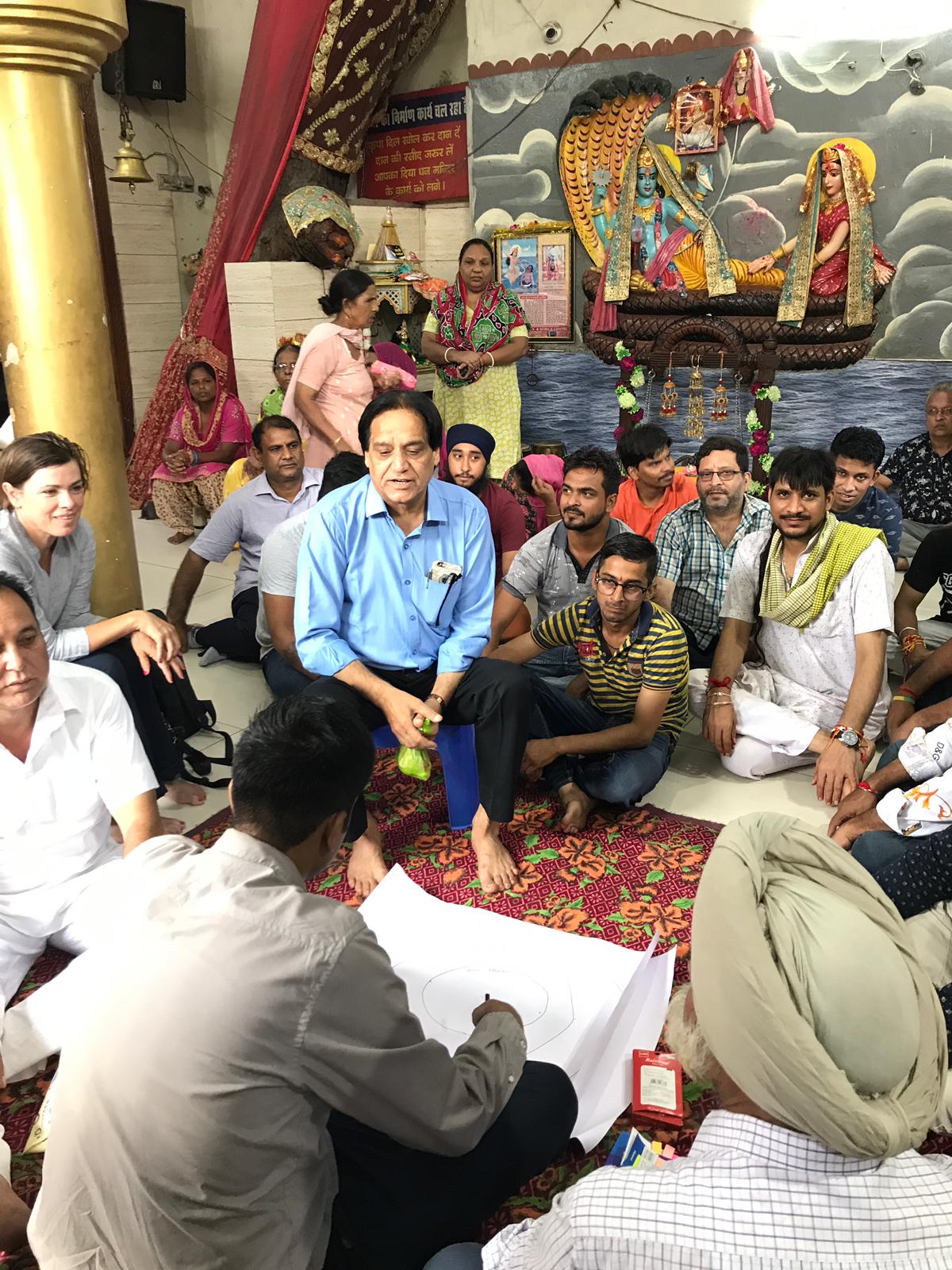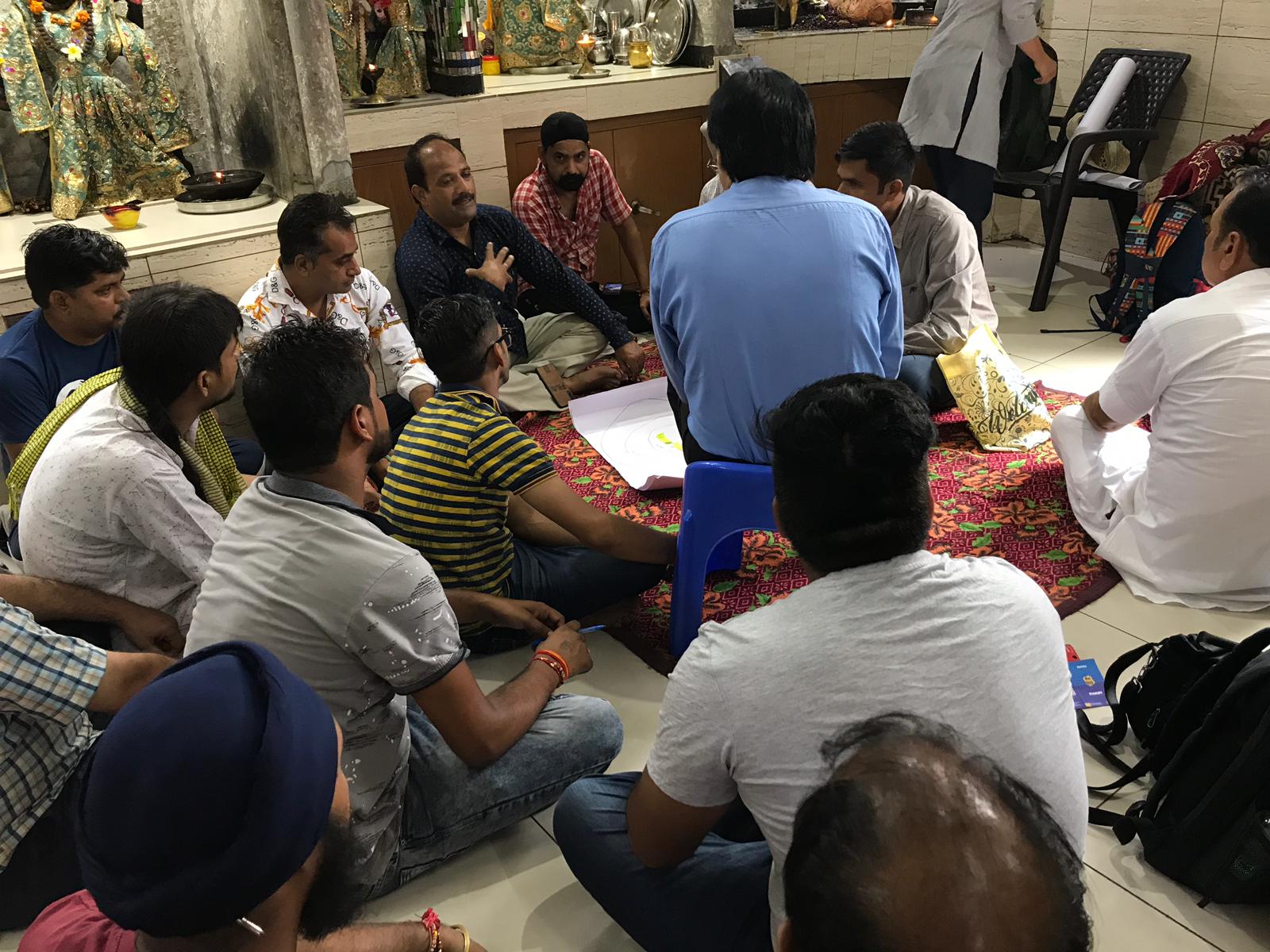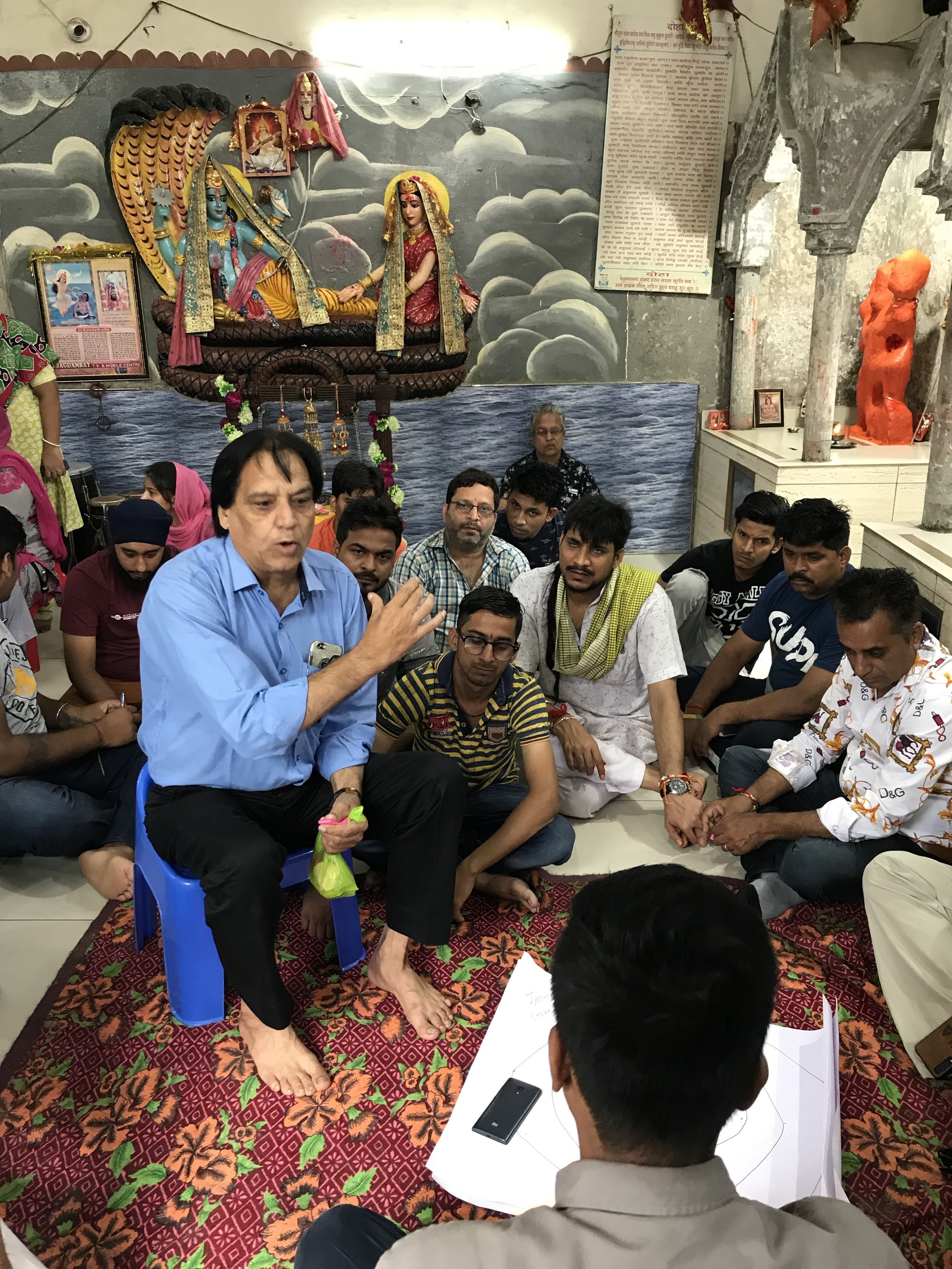Jalandhar Jyoti Chowk Community Asset Mapping Workshop Report
17 August 2019
“This right here is the heart of Jalandhar”
-A street vendor at Jyothi chowk
How do the vendors and traders in bazaars, a vital population in our cities, perceive urban transformations sought by the smart city mission? To understand this all important question the research project team held a Community Asset Mapping (CAM) workshop at the Kali Mandir in the busy Jyoti Chowk market area on the morning of August 17th .
The market area around the Chowk (junction) has multiple community stakeholders from traders with formal shops to traders with informal shops to regular street vendors to itinerant street vendors trading on daily or even hourly basis. We particularly focused on the informal trading economy which has developed along the old GT road from Police division 4 to Rainik bazaar. Popularly known as Sudama market/old clothes market and the sabji-fruit mandi market, hundreds of vendors’ trade here in this densely packed space. Sudama market deals with clothes and is composed of two groups: a largely Punjabi group trading in new clothes and the Gujarati group trading in second hand clothes. The sabji mandi market trades in vegetables and fruits and is adjoining the popular Rainik bazaar. These two informal markets are particularly vulnerable as they trade on highly contested land claimed by several actors like municipality, central government and Waqf board alike. The traffic junction improvement project of the Smart city mission which aims to reduce congestion around 11 chowks including Jyoti chowk and promote pedestrianisation by building footpaths has yet again bought back the issue of threat of displacement of vendors and traders.
Present Layout plan of Sudama and sabji market adjoining Jyoti Chowk prepared by the municipality. The various vendor shops and the Kali Mandir are clearly marked out.
Around twelve vendors including both the two pradhans (informal leader figures) of Sudama market and the Sabji mandi market participated in the CAM workshop. Firstly the participants were asked to list the existing community assets of the market into three categories: most important, less important and least important. All the vendors were in agreement that the Kali Mandir and their market were the most important assets for them.



We then asked them to list down the future assets they would like to see in the Jyothi chowk market area. Regularization of their shops was a very important concern as most of them were third generation traders still vulnerable for eviction. The smart city should make proper shops here and everyone should be settled properly felt many vendors. A pradhan quipped in ‘Smart city mein hum bhi ayengena, Agar smart city banayenge aur humko yaha se ujaad denge to smart city kaisi rahegi’ (If they make the smart city and in the course of it evict us, how can it still be called a smart city). ‘If the shops are taken away from us our kids have no option but to become daku (bandits)’ remarked a vendor.
They refused to see themselves as encroachers, a term the media, NGO’s and middle classes often have thrown against them. They feel that not only do contribute to the city’s economy but also are guardians of this land adjoining the chowk. ‘Humari hi waje see sarkar ki arbo rupaye ki zameen bachi hain. Bade bade aadmi ne bahut kabze kiye hai, hum to gareeb aadmi baite hai idhar (It is because of us this government land is safe. Big shots have grabbed land across the city. We are just poor traders). We are even ready to do compromise. You take 1 rupee, but we at least give us back 8 anna” put in one of the pradhan. They were keen to show us that they were improving their market constantly. ‘It is not like we don’t want to become smart, earlier used to use multiple ordinary phones but as the situation got updated now we are using smart phones. If these shops look like shacks it is not because we have not tried. Being a vulnerable vendor is not a conscious choice’ noted a vendor.
Parking space also emerged as a major concern for the vendors and traders. They said that instead of tearing down their market for a parking complex as the administration has been trying to do from years, they should execute the project in the old kacheri (district court) land (now belonging to PUDA) further along the old GT road which was ‘empty’ anyway. ‘All the parking around the bazaar is currently paid. Traders are spending 200 Rs per day. And on festivals and holidays the existing parking can’t even take up the load’ a vendor complained.
Water supply, washroom and garbage free land (which has accumulated on the empty space behind their shops) were also seen as important future assets. There is garbage accumulated in the market enough for 300 garbage trucks the vendors noted. Water supply was seen as crucial as the market has caught fire twice in the span of last 4 years. ‘Everything was destroyed. We had to take loans and rebuild our shops’, remembered a vendor.
When we asked them to map the less important future assets in their market the vendors refused saying everything was important. The pradhan quipped in ‘There is nothing as less important asset. We require all these. The idea of less important asset makes sense only if something was there. There is not much anyway so we can’t place any assets in the less important circle’.
The participants were later invited to repeat the asset mapping exercise at the city level. Many vendors included historically important religious places in the city as most important existing assets. Vendors also fondly remembered the experience of watching cinemas in single screen theatres (an important asset) which had all disappeared now. ‘We had 5 of them around Jyothi Chowk itself within a 100 meters range. Ticket used to cost Rs 2 then. Now even if we like going to the cinemas we hesitate as it is going to be so costly. Popcorn only is 200 Rs now! These will also go soon maybe. Now we hear Reliance is coming with a new scheme that on the same day they will release the movie in mobile’ said a vendor.
On the issue of future assets to be created for the city many of the young vendors also suggested a drug free Punjab and employment opportunities. ‘Unemployment is the biggest problem of the youth as lakhs of them are unemployed. People who have done graduation are driving autos to make a living; Unemployment is the root cause of all problems. If we can earn and eat a day’s meal then other issues seem less important’ summed up a vendor. It also emerged that most youth wanted to migrate in search of better opportunities. One of the pradhans remarked ‘Tomorrow if Australia says they will offer PR/visa then these people will just open the Google map and probably just start walking all the way up to Australia’!
They were however all skeptical about the urban transformation promised by the smart city. ‘It has been 4 years since the smart city; you tell me has anything happened on ground’. Another said ‘Jalandhar mein kabhi nahi bansakti hai yeh smart city. The complexities of India is different from London or Australia we have poverty, social division etc’.
One of the interesting things to emerge at the city level mapping was that in sharp contrast to the middle class participants in the CAM workshop at Burlton Park, the vendors strongly argued for the logic of retro-fitting; making the existing city smart rather than tearing it down and remaking it. When asked whether the old city consisting of mohallas (old localities with narrow streets and dense constructions) can be made smart a vendor asked us to look in depth why the mohalla form of human settlements developed historically that way. “You see it was actually for safety reasons. There was constant warfare those times and the narrow streets meant that an invading army could not easily move about. The dense construction meant that from above they could counter attack the invading army. Also density guarantees safety as unlike a colony you can always tell your neighbour to watch your house if you went out. Neighbours also looked upon each other’s children in mohallas’. He concluded by arguing that “Hindustan ban nahi raha, Hindustan bana hua hai, jo sheher unne mil chuke hai wo already bane hai, unko tabah nahi kiya jaasakta…purane aur naye ka mel ho na chahiye’ (India is not being made, it already is made. The cities we got (after independence) were already made, we can’t destroy them. We should combine the old and new elements’)


